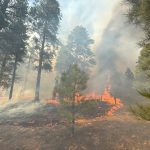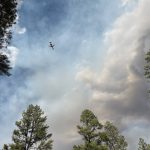
ARPA spending bill provides $180M for administration
WINDOW ROCK
Paving the way for the Navajo Nation to appropriate and spend $1.86 billion in American Rescue Plan Act funds, on July 24 Navajo Nation Council approved a bill establishing a fund and a framework to do so.
“The legislation creates a fund within the Navajo Nation called the Fiscal Relief Fund,” said Delegate Carl Slater, the bill’s sponsor. “It also sets the protocols and parameters by which money can be expended from that fund and within those parameters talks about processes, procurement and oversight …”
Slater said the fund is similar to the Sihasin Fund where any money that is going to be spent has to be approved by a two-thirds vote of Council and signed by the president.
The bill also establishes an application process for ARPA funds, waives certain provisions of the Appropriations Act, simplifies emergency procurements, and establishes a Fiscal Recovery Fund Office under the president’s office.
And, it allocates 10% of the ARPA funds, or approximately $180 million, off the top to the Navajo government for administration of the funds, including “central support services and regulatory costs.”
Per an agreed-upon formula, 90% of the $180 million, or a cool $162 million, will go to the president’s office and 10% percent, or $18 million, will go to the speaker’s office.
The OPVP will be responsible for apportioning the $162 million among executive branch programs and offices, including the controller’s office, Office of Management and Budget, Department of Justice, Washington office, Division of Human Resources, Division of Community Development and the FRF office.
Per the legislation, the FRF office will be a clearinghouse that will educate the public, ensure compliance with ARPA and Navajo Nation laws and regulations by all entities receiving money and will oversee spending and completion of projects and services.
“The way this is set up, the Fiscal Relief Fund Office has to present their plan of operation to the Naabik’iyati Committee, which is to be determined, before it starts running,” said Slater. “At the end of each quarter they have to report back as to what they’re doing through the office.”
Speaker Seth Damon and the Naabik’iyati Committee will be responsible for apportioning the $18 million amongst legislative branch programs and offices providing ARPA support services, including legislative services, legislative counsel, speaker’s office and Council.
All programs and offices receiving funds will be responsible for developing the legal, financial, organizational, managerial, regulatory and reporting framework necessary to support the quick completion of ARPA projects and services.
Damon stood by the 10% allocation for administration with the 90/10 formula saying it was the result of intensive negotiations between the three branch chiefs.
“For the past four months, we’ve been working together with all of the departments and divisions to get guidance,” Damon told Council. “I support this legislation the way it’s written because this is the input that we got from the legislative, executive and judicial branches.”
“I can honestly say working together on both sides of the street, with attorneys and DOJ, with recommendations from OOC and OMB, this is the best possible legislation we came forward with,” he added.
Chief Legislative Counsel Dana Bobroff added that one of the biggest challenges with the CARES Act funding was that there were no support costs allocated up front.
“Additional staff, additional processes, experts, project managers were not brought in first so that the legal/financial management infrastructure could be in place,” she said.
Many delegates agreed that this caused delays and put CARES Act projects at risk for not being completed from the get-go.
Bobroff said she believes using the 10% measurement is reasonable.
“The 10 percent is about half of what the Nation’s indirect costs rate is for projects,” she said.
Slater explained that when you receive a grant or any money that comes to the Navajo Nation, the Nation skims off a portion off the top for financial and legal management and any unused money gets returned.
“In my experience, around 10 percent is what they end up using,” he said.
Delegate Eugenia Charles-Newton challenged exactly where the 10% figure came from and if there was documentation to back it up, saying she felt there were too many unanswered questions.
“A three-branch agreement is not written into law,” she said. “We should have been consulted about this and there should have been a conversation prior to this legislation coming out to make sure that all of these ideas were taken into consideration when deciding the 90/10 formula.”
Neither the OPVP nor the speaker’s office responded to a request from the Navajo Times for additional background information and written documentation backing up the 10% allocation for administration of ARPA monies.
Charles-Newton was the only delegate who voted against the legislation.
As a safeguard, Slater said that per an amendment added to the legislation by Delegate Daniel Tso, any of the $180 million of administrative funds unencumbered or unspent by the end of the second quarter of Fiscal Year 2024 will be reverted back to the Fiscal Relief Fund and will be available for allocation to other projects and services.
The bill also authorizes reimbursements of Síhasin Fund and Unused Undesignated Fund Balance appropriations that were made through the previous CARES Act allocations.
The bill is expected to be signed by President Jonathan Nez, who supported it.
As another accountability measure, Slater said within 30 days of the bill being signed, the controller is obligated to set up a website that will enable the public to observe transactions conducted with the Fiscal Relief Fund.
As a public service, the Navajo Times is making all coverage of the coronavirus pandemic fully available on its website. Please support the Times by subscribing.
How to protect yourself and others.
Why masks work. Which masks are best.
Resources for coronavirus assistance








 Highway 264,
Highway 264, I-40, WB @ Winslow
I-40, WB @ Winslow